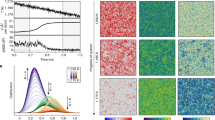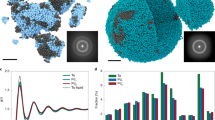Abstract
Silicon in its liquid and amorphous forms occupies a unique position among amorphous materials. Obviously important in its own right, the amorphous form is structurally close to the group of 4–4, 3–5 and 2–6 amorphous semiconductors that have been found to have interesting pressure-induced semiconductor-to-metal phase transitions1,2. On the other hand, its liquid form has much in common, thermodynamically, with water and other ‘tetrahedral network’ liquids that show density maxima3,4,5,6,7. Proper study of the ‘liquid–amorphous transition’, documented for non-crystalline silicon by both experimental and computer simulation studies8,9,10,11,12,13,14,15,16,17, may therefore also shed light on phase behaviour in these related materials. Here, we provide detailed and unambiguous simulation evidence that the transition in supercooled liquid silicon, in the Stillinger–Weber potential18, is thermodynamically of first order and indeed occurs between two liquid states, as originally predicted by Aptekar10. In addition we present evidence to support the relevance of spinodal divergences near such a transition, and the prediction3 that the transition marks a change in the liquid dynamic character from that of a fragile liquid to that of a strong liquid.
This is a preview of subscription content, access via your institution
Access options
Subscribe to this journal
Receive 12 print issues and online access
$259.00 per year
only $21.58 per issue
Buy this article
- Purchase on Springer Link
- Instant access to full article PDF
Prices may be subject to local taxes which are calculated during checkout




Similar content being viewed by others
References
Ponyatovsky, E. G. & Barkalov, O. I. Pressure-induced amorphous phases. Mater. Sci. Rep. 8, 147–191 (1992)
Brazhkin, V. V., Lyapin, A. G., Popova, S. V. & Voloshin, R. N. Nonequilibrium phase-transitions and amorphization in Si, Si/GaAs, Ge, and Ge/GaSb at the decompression of high-pressure phases. Phys. Rev. B 51, 7549–7554 (1995)
Angell, C. A., Bressel, R. D., Hemmatti, M., Sare, E. J. & Tucker, J. C. Water and its anomalies in perspective: tetrahedral liquids with and without liquid-liquid phase transitions. Phys. Chem. Chem. Phys. 2, 1559–1566 (2000)
Poole, P. H., Sciortino, F., Essmann, U. & Stanley, H. E. Phase behaviour of metastable water. Nature 360, 324–328 (1992)
Saika-Voivod, I., Sciortino, F. & Poole, P. H. Computer simulations of liquid silica: equation of state and liquid–liquid phase transition. Phys. Rev. E 63, 011202–011210 (2001)
Glosli, J. N. & Ree, F. H. Liquid–liquid phase transformation in carbon. Phys. Rev. Lett. 82, 4659–4662 (1999)
Katayama, Y. et al. A first-order liquid–liquid phase transition in phosphorus. Nature 403, 170–173 (2000)
Spaepen, F. & Turnbull, D. in Laser–Solid Interactions and Laser Processing–1978. AIP Conf. Proc. 50 (eds Ferris, S. D., Leamy, H. J. & Poate, J. M.) 73 (Ann. Inst. Phys., 1978)
Bagley, B. G. & Chen, H. S. in Laser–Solid Interactions and Laser Processing–1978. AIP Conf. Proc. 50 (eds Ferris, S. D., Leamy, H. J. & Poate, J. M.) 97 (Am. Inst. Phys., 1978)
Aptekar, L. I. Phase transitions in noncrystalline germanium and silicon. Sov. Phys. Dokl. 24, 993–995 (1979)
Donovan, E. P., Spaepen, F., Turnbull, D., Poate, J. M. & Jacobson, D. C. Calorimetric studies of crystallisation and relaxation of amorphous Si and Ge prepared by ion implantation. J. Appl. Phys. 57, 1795–1804 (1985)
Thompson, M. O. et al. Melting temperature and explosive crystallization of amorphous silicon during pulsed laser irradiation. Phys. Rev. Lett. 52, 2360–2363 (1984)
Poate, M., Percy, P. S. & Thompson, M. O. The melting of amorphous Si. Mater. Res. Soc. Symp. Proc. 57, 465–485 (1987)
Deb, S. K., Wilding, M., Somayazulu, M. & McMillan, P. F. Pressure-induced amorphization and an amorphous–amorphous transition in densified porous silicon. Nature 414, 528–530 (2001)
Luedtke, W. D. & Landman, U. Preparation and melting of amorphous silicon by molecular dynamics simulations. Phys. Rev. B 37, 4656–4663 (1988)
Angell, C. A., Borick, S. & Grabow, M. Glass transitions and first order liquid-metal-to-semiconductor transitions in 4–5–6 covalent systems. J. Non-Cryst. Solids 205–207, 463–471 (1996)
Keblinski, P., Bazant, M. Z., Dash, R. K. & Treacy, M. M. Thermodynamic behavior of a model covalent material described by the environment-dependent interatomic potential. Phys. Rev. B 66, 064104-1–064104-14 (2002)
Stillinger, F. H. & Weber, T. A. Computer simulation of local order in condensed phases of silicon. Phys. Rev. B 31, 5262–5271 (1985)
Sastry, S., Debenedetti, P. G., Sciortino, F. & Stanley, H. E. Singularity-free interpretation of the thermodynamics of supercooled water. Phys. Rev. E 53, 6144–6154 (1996)
Horbach, J. & Kob, W. Static and dynamic properties of a viscous silica melt. Phys. Rev. B 60, 3169–3181 (1999)
Speedy, R. J. & Angell, C. A. Isothermal compressibility of supercooled water and evidence for a thermodynamic singularity at -45 °C. J. Chem. Phys. 65, 851–858 (1976)
Angell, C. A., Ngai, K. L., McKenna, G. B., McMillan, P. F. & Martin, S. W. Relaxation in glassforming liquids and amorphous solids. J. Appl. Phys. 88, 3113–3157 (2000)
Horbach, J., Kob, W. & Binder, K. High frequency sound and the boson peak in amorphous silica. Eur. Phys. J. B 19, 531–543 (2001)
Sokolov, A. P., Rössler, E., Kisliuk, A. & Quitmann, D. Dynamics of strong and fragile glass formers: Differences and correlation with low-temperature properties. Phys. Rev. Lett. 71, 2062–2066 (1993)
Ansell, S., Krishnan, S., Felten, J. J. & Price, D. L. Structure of supercooled liquid silicon. J. Phys. Condens. Matter 10, L73–L78 (1998)
McMillan, P. F. New materials from high-pressure experiments. Nature Mater. 1, 19–24 (2002)
ten Wolde, P. R. & Frenkel, D. Enhancement of protein crystal nucleation by critical density fluctuations. Science 277, 1975–1978 (1997)
Ovshinsky, S. in Insulating and Semi-conducting Glasses (ed. Boolchand, P.) 12 (World Scientific, Singapore, 2000)
Brown, D. & Clarke, J. H. R. A comparison of constant energy, constant temperature and constant pressure ensembles in molecular dynamics simulations of atomic liquids. Mol. Phys. 51, 1243–1252 (1984)
Wang, Z. Q. & Stroud, D. Bond-orientational order in liquid Si. J. Chem. Phys. 94, 3896–3900 (1991)
Acknowledgements
We thank S. Balasubramanian, G. H. Gilmer, P. H. Poole, F. Sciortino, J. Horbach, R. D. Mountain and W. Kob for useful discussions and comments on the manuscript.
Author information
Authors and Affiliations
Corresponding author
Ethics declarations
Competing interests
The authors declare that they have no competing financial interests.
Rights and permissions
About this article
Cite this article
Sastry, S., Austen Angell, C. Liquid–liquid phase transition in supercooled silicon. Nature Mater 2, 739–743 (2003). https://doi.org/10.1038/nmat994
Received:
Accepted:
Published:
Issue Date:
DOI: https://doi.org/10.1038/nmat994
This article is cited by
-
Microscopic mechanisms of pressure-induced amorphous-amorphous transitions and crystallisation in silicon
Nature Communications (2024)
-
Anisotropy in spinodal-like dynamics of unknown water at ice V–water interface
Scientific Reports (2023)
-
Folded network and structural transition in molten tin
Nature Communications (2022)
-
Pressure-induced liquid-liquid transition in a family of ionic materials
Nature Communications (2022)
-
Machine learning reveals the complexity of dense amorphous silicon
Nature (2021)



